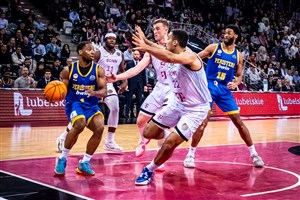Midweak crowds an issue to grapple with
MELBOURNE (Paulo Kennedy’s View from Downunder) - The 7500-seat Margaret Court Arena, which has always had great potential for basketball, finally made its hoops debut this week.
Unfortunately, with Melbourne United playing lowly-drawing Cairns on a Wednesday night during exam period, only around 3000 people turned out despite tickets being offered for $10.
One fan on social media wrote “Midweek NBL games don’t attract crowds” and they are correct.
The three midweek games in the opening six rounds have drawn 10,000 people in total, well down on the 5400 average the three host teams have attracted for weekend games so far this season.
But fans need to get used to it, because the league needs midweek games for a very good reason…
TV
NBL games hold little currency in television land in weekend timeslots, but broadcasters desire live sport on weeknights, and that opens the chance for a deal that delivers much-needed dividends to clubs.
Potential TV partners have also made it clear they don’t want to broadcast basketball over a six-seventh month season.
With NBL teams not owning their own stadiums they are at the mercy of other, often more lucrative bookings on weekends, making midweek games essential to condense the fixture.
But it’s not just for broadcast partnerships that playing midweek games makes sense.
The chatter
If you want people talking about the NBL, you need to give them something to talk about, and with only five or six games a week there isn't a lot of news.
Some sports in Australia generate all sorts of news – injuries, team selections, coach speculation, celebrity gossip – but in Australian basketball that either doesn’t exist or doesn’t make the grade.
The story is the game as far as basketball is concerned, that’s part of the reason league CEO Fraser Neill wants more teams playing more games.
The spectacle
Another little-considered factor is the more games teams play, the less research goes into defensive plans, which leads to more high-scoring games and more highlight plays.
If there is one or more games on every night, news outlets looking for content will know they can always grab a dunk or blocked shot from the NBL.
That’s where it essential for the league to provide the best-quality highlights, not leaving it to network employees who don’t care about the sport to quickly pull something out.
Best of all, if you double or triple the number of games, you double or triple the number of weekly highlights, which will start to tear down perception nothing exciting happens on NBL courts.
The H, the O, the W
Of course, the big question is how do you get it to work?
Legendary SEABL coach Bill Runchey once told me balance is the key to everything in life, from sport, to work, to family and beyond.
Some troubling reports emerged that members of the NBL hierarchy had an unexpected disagreement about the league’s future direction in front of some shocked potential investors.
One preferred the traditional model – playing games on weekends in big stadiums – while the other wanted a new model that involves more games played in smaller, less expensive venues.
The key here is balance.
If the shoe fits
Weekend games against opponents who draw a crowd, which are good candidates for national free-to-air television, should be in big stadiums.
Weeknight games - unless they have some marketable features - should in most cases be played in smaller venues, preferably closer to people’s homes.
Wednesday’s game at Margaret Court Arena was never going to succeed. Even if a TV deal was in place, the viewers get a quiet, sparsely-populated stadium and that’s not a good look.
Had it been played at the 3200-seat State Basketball Centre (SBC) in Melbourne’s suburban hoops heartland, it would have drawn a similar crowd, the atmosphere would have been excellent and the event profitable.
Make it predictable
There’s no point scheduling games on random weeknights through the season in the middle of big cities. Most people won’t want to head into town and many won’t even know the game is on.
If a Melbourne team is to play midweek games, schedule them on the same day of the week either weekly, fortnightly or once a month at the SBC, as an example.
Create predictability and people will get used to when games are on. If the stadium is close to home, the dissuasion midweek games currently carry will fade.
You’ve got the look
Some say smaller stadiums without seating at the end of the court don’t present well on TV, but the reality is with some well-designed banners – be they logos of club, league, major sponsors or all three – they will look good and give quality advertising space.
MSAC, SBC, WA Basketball Centre, Dandenong and ETSA Park in Adelaide are all examples of small stadiums that look good on television.
Watching Townsville play at the RSL Stadium this year, the atmosphere that comes across is fantastic – much better than some music-playing big stadiums – and with some branding work at the ends it will be a good venue to spectate via broadcast.
Buying in
The most important point is all clubs must buy in to a system that works for the league, not just them. It’s about finding a balance.
For Perth it might be playing most games at Perth Arena under their current model, but then a small bunch of games at the WA Basketball Centre during the Hopman Cup recess.
For the new Brisbane team next season it could be the opposite.
Play some marquee games at Boondall, for example, which can be promoted as a major event, with the rest at a location like Chandler that is low cost and still has a good atmosphere for midweek games.
Quite simply, the NBL needs more games, that means midweek games, and that requires some intelligent thinking to make sure they don’t alienate fans and become a financial burden for clubs.
Paulo Kennedy
FIBA
FIBA's columnists write on a wide range of topics relating to basketball that are of interest to them. The opinions they express are their own and in no way reflect those of FIBA.
FIBA takes no responsibility and gives no guarantees, warranties or representations, implied or otherwise, for the content or accuracy of the content and opinion expressed in the above article.















